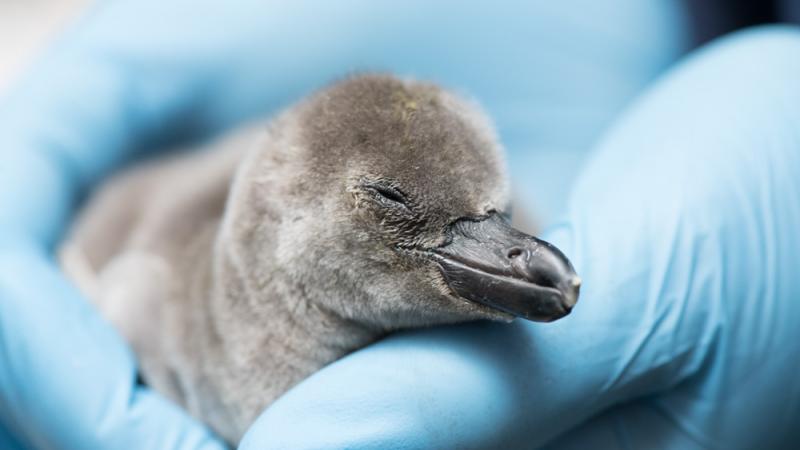With pips and peeps, fluffy penguin chick hatches at zoo

Fuzzy gray hatchling joins the Humboldt colony at Penguinarium
After a couple of peep-filled days spent emerging from its shell, a new chick joined the Oregon Zoo's Humboldt penguin colony yesterday morning.
"The hatching went just the way it's supposed to," said Travis Koons, who oversees the zoo's bird population. "The chick appears to be healthy and active, and its parents are caring for it well."
The young penguin began "pipping" (when a chick's beak breaks through the membrane of its shell) on Friday, and emerged early Monday morning. Humboldt penguins typically hatch 40 days after eggs are laid, and it takes two or three days from internal pip for the chicks to fully emerge from the shell, according to Koons.
The fluffy, pint-sized new arrival — which is small enough to fit in the palm of your hand — is the 191st Humboldt chick to hatch at the zoo since it began breeding the threatened species in the 1980s.
It will be nearly as tall as its parents by the summer, but easy to tell apart by its plumage: Young Humboldts are grayish-brown all over and don't develop their distinctive black-and-white tuxedo markings for a couple years.
Once it's waddling and swimming on its own, the chick will begin to explore the rugged terrain of the zoo's Penguinarium, which simulates the endangered birds' native habitat along the rocky coast of Chile and Peru. Until then, Koons says, the young bird will be keeping cozy inside its nest box, growing strong on a diet of regurgitated "fish smoothie" provided by its devoted parents.
Once they fledge, at around 3 months old, young penguins can swim right away — no lessons needed — and visitors should have good views of these sleek sea birds darting through the clear waters of the zoo's Penguinarium. In 2012, the zoo completed an upgrade of the Penguinarium's water-filtration system, one of many improvements funded by the community-supported 2008 zoo bond measure aimed at protecting animal health and safety while conserving and recycling water. The upgrade saves millions of gallons each year.
Humboldt penguins, which live along the South American coastline off of Peru and Chile, are classified as "vulnerable" by the International Union for Conservation of Nature, and in 2010 were granted protection under the U.S. Endangered Species Act. Of the world's 17 penguin species, Humboldts are among the most at risk, threatened by overfishing of their prey species, entanglement in fishing nets, and breeding disruption due to commercial removal of the guano deposits where the penguins lay their eggs. Their population is estimated at 12,000 breeding pairs.
More News

Zoo seeks pika watchers for summer season
The Oregon Zoo is recruiting volunteers for Cascades Pika Watch.April 15, 2025

Zoo convenes action for imperiled elephants
Sabah government representatives joined conservation NGOs, local communities, palm oil producers, and tourism operators this week in the fight to save the world’s smallest elephants from extinction.April 11, 2025

Double fluff: Zoo welcomes first condor chicks of season
The first two California condor chicks of 2025 hatched at the Oregon Zoo’s Jonsson Center for Wildlife Conservation.April 3, 2025

